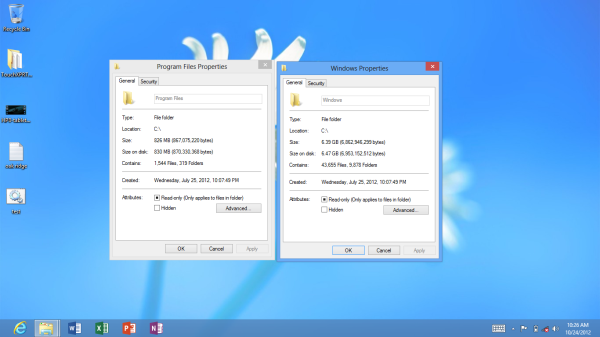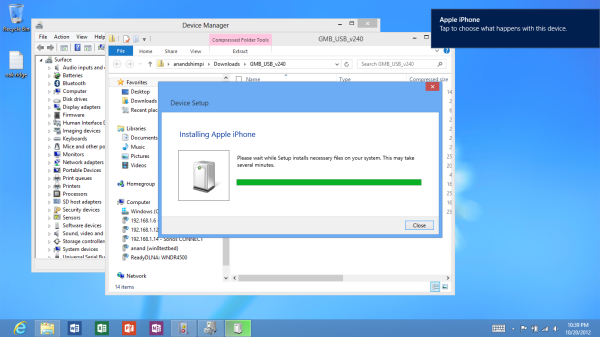The Windows RT Review
by Vivek Gowri & Anand Lal Shimpi on October 25, 2012 12:00 PM EST- Posted in
- Windows RT
- Operating Systems
- Microsoft
- Mobile
- Windows 8
- Tablets
UI Performance, Storage, and USB Compatibility
by Vivek Gowri and Anand Shimpi
With Windows Phone 7, Microsoft did a great job of taking generation-old hardware and delivering a great user experience in spite of any silicon-level deficiencies. So naturally, with the new Windows UI, we were expecting a very smooth UI regardless of the underlying hardware. And they’ve most certainly delivered on that.
Animation frame rates are consistently good all the way through the UI, easily delivering what appears to be 60 fps for UI transitions. When pushed, Modern UI seems more likely to completely drop animations versus dropping frames, which eliminates the choppy experience you sometimes find in Android. It isn’t a common occurrence, the experience is generally very fluid. This kind of consistently smooth UI is what Google has been striving for in every recent release of Android, dedicating the release of 4.1 to eliminate the dropping of frames in even basic interactions. Scrolling, swiping, snapping, app switching - it doesn’t really matter what you’re doing, RT is just really smooth. Combined with the fluidity of the gestures, the entire system just feels like liquid, there are just no real slowdowns even running on a no-longer impressive SoC like Tegra 3.
| Application Launch Time Comparison | |||||||
| Boot | Web Browser | Maps | Games Center / Xbox | ||||
| Apple iPad (3rd gen) | 32.0s | 1.0s | 2.4s | 1.1s | 1.9s | ||
| Microsoft Surface | 27.7s | 2.6s | 7.1s | 5.0s | 5.0s | ||
But there is one area that RT struggles in, and it’s something that was an issue in Windows Phone 7 too - application launch times. Anand included this table in his Surface review, and it shows that boot performance is decent, but the 3rd generation iPad just kills it in application loading. The new A6X-infused 4th gen iPad probably widens that gap too, so it’s a pretty stark difference. It’s something that Microsoft needs to really focus on when updating the OS, because it’s easily one of the most glaring flaws in an otherwise stellar interface.
From a storage standpoint, the OS takes up between 6.5 and 7.5GB of space (Anand measured 6.47GB on Surface, I measured 7.35GB on the VivoTab RT) and Office takes up another 750-850MB (830MB for Surface, 749MB for the ASUS), so you’re looking at 7.5-8GB of NAND dedicated to the OS. On my 32GB VivoTab RT, I had 25.3GB of storage to start with, so after Windows and Office, I was looking at 17GB left over for programs and documents. That’s....not a lot - a bit of music, a decent selection of applications, a couple of videos, and pretty soon I’m looking at less than 10GB of storage left over. Thankfully, we’re seeing microSD slots on a lot of the more prominent Windows RT slates, so if you run out of room, you could theoretically toss in a 32GB or 64GB microSDXC card. Depending on how much data you plan on storing, I think you can get away with the lesser internal NAND and some microSD cards.
It’s also pretty clear that there will not be a Windows RT slate shipped with less than 32GB of onboard NAND. If you’re holding out for a cheaper Windows RT device with less storage, like a 16GB tablet for $399, there’s almost no way that happens - it’s implausible to think that anyone would ship a tablet with less than 5GB of space left for data storage.
Another key detail in Windows RT is wide-ranging USB peripheral support. USB ports have been a common feature on 10” Android tablets, but device support was typically limited to flash drives and basic input devices. The goal with Windows RT was to bring the traditional Windows experience to tablets, so USB driver support is pretty important. It’s not as easy as on an x86 system, where most USB peripherals would just work, but even with more limited Windows-on-ARM drivers, it’s pretty decent overall.
USB drives obviously work as you’d expect them to. Even SATA to USB adapters worked fine when plugged into Surface. Other smartphones and tablets also worked, although their level of support varied. For example, you can plug in the iPhone 5 and have it come up as a supported device for moving pictures to/from. However USB tethering is not supported by the class driver included in Windows RT. You can even plug an iPad into Surface and get the same level of support. The few Android phones I tried to connect in MTP all worked as expected, though transfer rates off my Optimus 4X HD seemed on the slow side, likely a function of the phone’s internal eMMC.
Printer support is pretty decent, although the Epson Workforce 910 Anand tried didn’t actually have specific driver support under RT. Although development for the desktop side of Windows is limited, manufacturers can supply Windows RT drivers to enable support for some more obscure devices. Unfortunately when it comes to those devices you’ll have to play the waiting game as there’s simply not a lot of third party Windows RT drivers available for download today.












233 Comments
View All Comments
mcnabney - Thursday, October 25, 2012 - link
CT is still Atom. These are processors that can be massively beaten by any Core2 Duo. A typical Core2 has 3-5x the performance power - so don't get too excited about productivity yet.They need to go the iPad3 route and just jam a huge battery in it. An i3 is what tablets need.
StormyParis - Thursday, October 25, 2012 - link
Except the iPad3 has nowhere near the power of a Core i3, it's a dual (or quad core ?) ARM that has nowhere near the oomph, nor power consumption, of an i3.Musafir_86 - Thursday, October 25, 2012 - link
Hi,-Thanks for the review, but I have some (minor) things to ask:
1. What's the Windows Experience Index (WEI) score? Could you put a screen capture of the individual ratings too?
2. Is System Restore on by default? What's the default reserved space for it?
3. Would you run some demos (or as many as you can) from IE Test Drive website for both Metro IE & Desktop IE and post the resulting FPS/scores here? Then compare the same demos on Atom's Win8 tablet and also maybe an x86 desktop/laptop Win8 system.
-Your consideration is really appreciated, thanks again.
Regards.
mcnabney - Thursday, October 25, 2012 - link
You really think Microsoft would put WEI in RT? It would likely be a 1 or 2 based upon some of the weak components. Remember, an ARM CPU is really a very very very weak CPU.Musafir_86 - Thursday, October 25, 2012 - link
-Hmm, it seems you're right - WEI scores don't exist on Windows RT:http://msdn.microsoft.com/en-us/library/windows/ha...
http://msdn.microsoft.com/en-us/library/windows/ha...
-However, I still want to know about the answers for other 2 questions. :)
Regards.
faizoff - Thursday, October 25, 2012 - link
I really hope a Modern UI app is made, it would be an excellent tool especially the bench tool. There are already quite a handful of tech site apps and they do a fairly good job of placing the website in tablet format.GotnoRice - Thursday, October 25, 2012 - link
This is going to be many people's first impression of both Windows 8 and a Microsoft Tablet, and both experiences are going to be ruined by ARM.Most won't realize that the REAL surface tablet, the one that runs actual x86 programs and not a handful of glorified phone apps from the microsoft app store, isn't out yet.
cappasay - Thursday, October 25, 2012 - link
If the price was better (i.e. $100 cheaper), I would easily go for the RT. I cannot imagine the Surface Pro replacing my full-time machine anyway, both in terms of screen size (my laptop is currently 13") and raw power.karasaj - Thursday, October 25, 2012 - link
Surface Pro will run an ULV ivy bridge, so I don't really see how it can't match a 13" ultrabook in terms of power.Unless you have something that isn't an ultrabook, but in that case, ULV will always lose to non-ULV, surface or not.
arcanetribe - Thursday, October 25, 2012 - link
Anand/Vivek,I'd have liked to see an assessment of what you think RT's capabilities are as far as malware rejection and security is concerned. Is it going to be more resilient than standard Windows 8?
Obviously it will be difficult to get a user to install a trojan with the MS Store requirement, but will drive-by infections still be a concern?